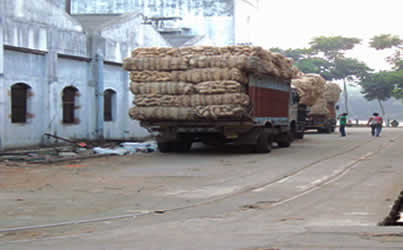
Raw jute in the form of bales are processed in our mills to produce hessian, sacking, jute yarn, bags, and other useful products. Raw jute bales from jute fields or suppliers, carried by trucks are unloaded are stacked in the jute mills gowdown. The production of jute goods from raw jute processing involves the following steps:
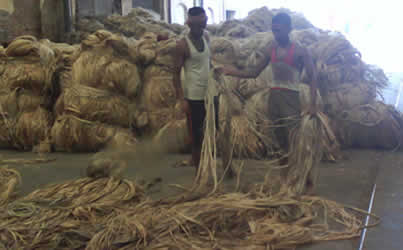
Selection, Softening & Piling:
In the selection process, raw jute bales are opened to find out any defect and to remove the defective portion from the morah by experienced workers. The bales are assorted according to spin like Hessian weft, Sacking wrap, Sacking weft etc. After selection, jute are carried to softning section. In this softning process jute becomes soft and pileable and suitable for carding.
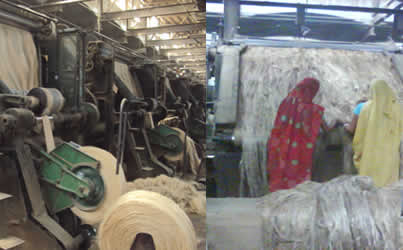
Carding:
Carding is a combining operation where jute reeds are splitted and extraneous matters are removed. Jute fibres are formed into ribbon called "sliver". There are three different carding sections:
1. breaker carding
2. inter carding
3. finisher carding
The Rolls made in Breaker Carding are of different qaulities. These rolls are brought together to inter carding machine for re-processing .This will also enhance the regularity Finisher carding machine make the sliver more uniform and regular in length and weight obtained from the Breaker carding machine.

Drawing(1st, 2nd & 3rd) :
The slivers obtained from finisher carding machine is fed on to the first drawing machine. The first drawing machines makes blending, equalising the sliver and doubling two or more slivers, level and provide quality and colour. The Second Drawing machine makes more uniform sliver and reduce the jute into a suitable size for third drawing The Third Drawing machine is of high speed makes the sliver more crimpled and suitable for spinning.
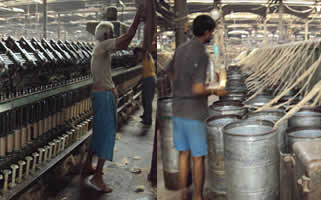
Spinning :
In the spinning process slivers are elongated and fibres are twisted into yarn to impart strength. spun yarns in the spinning process are wound onto Bobbins.
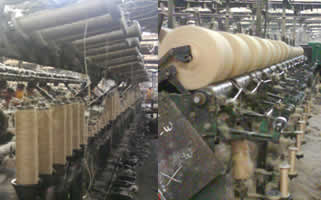
Winding:
Winding is a process which provides yarn as spools and cops for the requirement of beaming and weaving operations. There are two types of winding:
(i) Spool Winding
(ii) Cop Winding
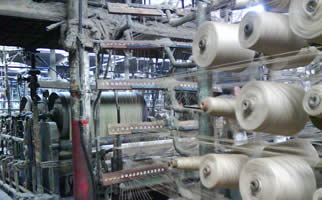
Beaming :
Beaming process follows after spool winding. In Beaming operation yarn from spool is wounded over a beam of proper width and correct number of ends to weave jute cloth.
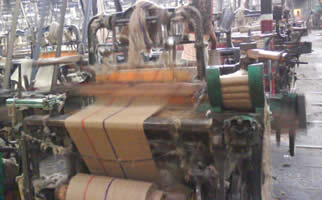
Weaving:
Weaving is a process of interlacement of two series of threads called "wrap" and "weft" yarns to produce the fabric of desired quality. There are separate looms for hessian and sacking in weaving section. The Hessian looms, shuttle which contents cops (weft yarn) is manually/ automatically changed. The sacking looms are equipped with eco-loader to load a cop automatically into the shuttle.
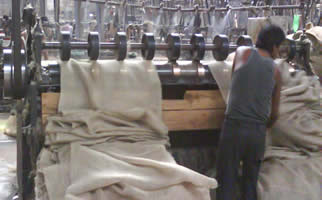
Damping & Calendering :
Damping is the process in which the rolled woven cloth is unrolled and water is sprinkled on it continuously to provide desired moisture.
Calendering is a process similar to ironing of fabric. After damping the damped fabric passes through pairs of heavy rollers rendering threads in fabric flattened and improve the quality and appearance.
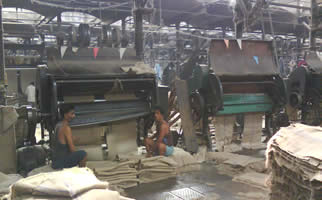
Lapping and Cutting:
Lapping is the process in which Hessian fabrics are folded into the required size used in "Bale press" operation on the lapping machine.
Cutting is the process where the sacking cloth is cut to the required length for making bags for different size such as A-Twill bags ,B-twill bags ,etc.
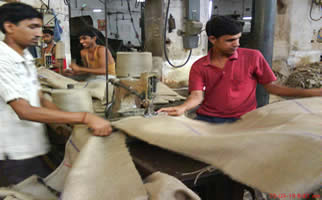
Hemming , Herackle Sewing & Safety Sewing :
In Hemming process, the raw edges of sacking cloth cut pieces are shown by folding it with sewing machine. In Herackele sewing the sides of sacking cloth cut pieces are sown to make a complete bag. In Safety sewing, the sides of sacking which was sown at the time of Herackle Sewing is again stiched to enhace the strength of the Bags edge.This kind of stiching is generally done on FCI bags.
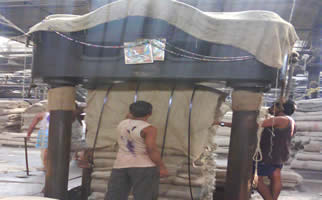
Bailing :
Bags or Bale processing cloths are pressed compactly according to buyers need.